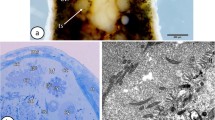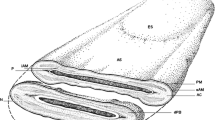Summary
Some aspects of spermiogenesis have been studied in the testis of the teiid lizard Cnemidophorus lemniscatus lemniscatus by electron microscopy. Shortly after the acrosomal vesicle is lodged in a nuclear concavity of the spermatid, a dense granule differentiates in the center of the subacrosomal space. It is cone-shaped and shows a longitudinal striation. Its base applies to the acrosomal membrane and, through this, to the acrosomal granule. Its rounded vertex causes a depression of the nuclear membranes which, initially juxtaposed, separates at this point to form a vesicle. The granule develops and becomes a rod when spermiogenesis is advanced and the subacrosomal space has taken the form of a secondary cap. The rod is cylindrical, retains its original striation and has a convex acrosomal end. It encloses the vesicle formed by the nuclear envelope in its base and follows the apex of the nucleus. Meanwhile, the acrosomal granule loses its identity and the acrosomal cap is filled with a dense substance, in which a fringe of translucent material differentiates. This fringe lies in the dorsal and apical margins of the acrosome and is incompletely divided by longitudinal crests of the dense acrosomal substance. A projection of the Sertoli cell forms an accessory cap which envelops the acrosome and is in turn covered by the cytoplasm of the spermatid, constituting an intricate association. Two reflex membranes underlie the plasmalemma in the outer surface of the projection of the Sertoli cell. They are continuous with one another at their ends and with the cell membrane in the edge of pores. In the peripheral cytoplasm of the spermatid facing the accessory cap, numerous microtubules run longitudinally. By means of thin membranes some are interconnected or connected with the plasmalemma, from which they seem to originate.
Similar content being viewed by others
References
Austin, R.C., Bishop, M.W.H.: Some features of the acrosome and perforatorium in mammalian spermatozoa. Proc. Roy. Soc. B 149, 234–240 (1958a)
Austin, R.C., Bishop, M.W.H.: Role of the rodent acrosome and perforatorium in fertwilization. Proc. Roy. Soc. B 149, 241–248 (1958b)
Blom, E., Birch-Andersen, A.: An “apical body” in the galea capitis of the normal bull sperm. Nature (Lond.) 190, 1127–1128 (1961)
Boisson, C., Mattei, X.: La spermiogenèse de Python sebae, Gmelin, observée au microscope électronique. Ann. Sci. nat., Zool., 12e. sér. 8, 363–389 (1966)
Brökelmann, J.: Fine structure of germ cells and Sertoli cells during the cycle of the seminiferous epithelium in the rat. Z. Zellforsch. 59, 820–850 (1963)
Burgos, M.H., Fawcett, D.W.: An electron microscope study of spermatid differentiation in the toad, Bufo arenarum Hensel. J. biophys. biochem. Cytol. 2, 223–240 (1956)
Clark, A.W.: Some aspects of spermiogenesis in a lizard. Amer. J. Anat. 121, 369–399 (1967)
Clermont, Y., Einberg, E., Leblond, C.P., Wagner, S.: The perforatorium — an extension of the nuclear membrane of the rat spermatozoon. Anat. Rec. 121, 1–12 (1955)
Del Conte, E.: Variación ciclica del tejido intersticial del testículo y espermiogénesis continua en un largarto teído tropical: Cnemidophorus l. lemniscatus (L.). Acta cient. venez. 23, 177–183 (1972a)
Del Conte, E.: Effects of metopirone on the structure of endocrine glands in the male lizard, Cnemidophorus l. lemniscatus (L.). Z. Zellforsch. 135, 27–43 (1972b)
Del Conte, E.: Différenciation des segments sexuels rénaux pendant la maturation sexuelle du Lézard mâle (Cnemidophorus l. lemniscatus). Arch. Anat. micr. Morph. exp. 63, 23–36 (1974)
Del Conte, E.: Correlated changes in the structure of the anterior pituitary gland, testes and interrenal tissue during sexual maturation of male lizards. Cell Tiss. Res. 157, 493–502 (1975a)
Del Conte, E.: Multinucleate spermatogenic cells by traumatic haemorrhagic suffusion in lizard testes. Virchows Arch. Abt. B 18, 297–305 (1975b)
Fawcett, D.W.: The anatomy of the mammalian spermatozoon with particular reference to the guinea pig. Z. Zellforsch. 67, 279–296 (1965)
Franklin, L.E., Fussell, E.N.: Evolution of the apical body in golden hamster spermatids with some reference to primates. Biol. Reprod. 7, 194–206 (1972)
Gordon, M.: Localization of the “apical body” in guinea-pig and human spermatozoa with phosphotungstic acid. J. Reprod. Fertil. 19, 367–369 (1969)
Grigg, G.W., Hodge, A.J.: Electron microscopic studies of spermatozoa. I. The morphology of the spermatozoon of the common domestic fowl (Gallus domesticus). Aust. J. sci. Res., Ser. B 2, 271–286 (1949)
Guraya, S.S.: Histochemical observations on the lizard spermiogenesis. Acta anat. (Basel) 79, 270–279 (1971)
Hadek, R.: Study on the fine structure of rabbit sperm head. J. Ultrastruct. Res. 9, 110–122 (1963)
Hopsu, V.K., Arstila, A.U.: Development of the acrosomic system of the spermatozoon in the Norwegian lemming (Lemmus lemmus). Z. Zellforsch. 65, 562–572 (1965)
Humphreys, P.N.: The differentiation of the acrosome in the spermatid of the budgerigar (Melopsittacus undulatus). Cell Tiss. Res. 156, 411–416 (1975)
Jensen, O.S.: Untersuchungen über die Samenkörper der Säugethiere, Vögel und Amphibien. I. Säugethiere. Arch. mikr. Anat. 30, 379–425 (1887)
Lenhossék, M. von: Untersuchungen über Spermatogenese. Arch. mikr. Anat. 51, 215–318 (1898)
Moricard, R.: Des structures de l'acrosome des spermatozoïdes contenus dans l'utérus chez la Lapine. C.R. Soc. Biol. (Paris) 155, 2243–2245 (1961)
Nagano, T.: Observations on the fine structure of the developing spermatid in the domestic chicken. J. Cell Biol. 14, 193–205 (1962)
Nicander, L., Bane, A.: Fine structure of the sperm head in some mammals with particular reference to the acrosome and the subacrosomal substance. Z. Zellforsch. 72, 496–515 (1966)
Sandborn, E.B.: Cells and tissues by light and electron microscopy. Vol. II. New York and London: Academic Press 1970
Sandoz, D.: Évolution des ultrastructures au cours de la formation de l'acrosome du spermatozoïde chez la Souris. J. Microscopie 9, 535–558 (1970)
Smith, P.E., Copenhaver, W.M.: Bailey's text-book of histology, 12th ed. Baltimore: The Williams & Wilkins Co. 1948
Yanagimachi, R., Noda, Y.D.: Fine structure of the hamster sperm head. Amer. J. Anat. 128, 367–387 (1970)
Author information
Authors and Affiliations
Additional information
This research forms part of project N∘. 31.26.S1-0244 supported by the Consejo Nacional de Investigaciones Científicas y Tecnológicas
Rights and permissions
About this article
Cite this article
Conte, E.D. The subacrosomal granule and its evolution during spermiogenesis in a lizard. Cell Tissue Res. 171, 483–498 (1976). https://doi.org/10.1007/BF00220240
Received:
Revised:
Issue Date:
DOI: https://doi.org/10.1007/BF00220240




